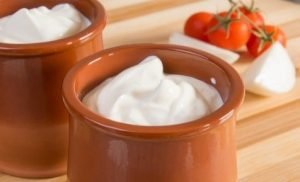What is E 407?
The E 407 additive, carrageenan is a substance that can act as a thickener, gelling, glazing and stabiliser.
Several polysaccharides extracted from red seaweeds of the Gigartimaceae, Solieriaceae, Hypneaceae and Furcellariaceae families of the Rhodophyceae class are known as carrageenan (E 407). They have a linear polygalactopyranose structure in which part of the hydroxyl groups are esterified with sulphuric acid. D-galactopyranose molecules are alternately linked by 1-3-α and 1,4-β bonds respectively having the hydroxyl groups of the C2 and or C6 carbon atoms esterified with sulphuric acid.
Industrial is obtained by water extraction as follows: whole algae are washed with cold water, then digested with hot water. They are homogenised, boiled, decolourised with bleaching earth, filtered at 70-80o C, purified by ion exchange, followed by concentration of the filtrate and precipitation with organic solvents. The substance is washed with alcohol, then dried under vacuum and ground. Due to its high viscosity, concentration of the filtrate is done only up to 1,5 % hydrocolloid in solution.[1]
How many types of carrageenan are there?
Depending on the degree of sulphation, there are three types of carrageenan:
- Kappa-caragenan, which has a single sulphate group per disaccharide,
- iota-carrageenan with two groups and
- lambda-carrageenan with three.
Read too:E551 – Silicon dioxide
Used as a food additive since the 15th century, carrageenan is a vegan alternative to gelatin, in addition to its other properties.[2]
Which foods contain the food additive E 407?
Carrageenan is used alone or in a mixture with E 400, E 401, E 402, E 403, E 404, E 406, E 410, E 412, E 415, E 418 in:
- gemuri,
- jellies,
- marmalade,
- fruit-based spreads and smoothies, and similar low-calorie products.
Add in:
- partially or totally dehydrated milk,
- pasteurised whole cream,
- post-weaning foods for healthy infants,
- stabilisation of milk and cocoa drinks,
- in yogurt,
- in dessert creams,
- in canned meat and fish.
- extruded protein products,
- in the flour products industry,
- pasta,
- sugary products.[3]
Read too:E950 Acesulfame K
Are there any side effects from consuming the food additive E 407?
Carrageenan is a difficult to digest substance. In high doses it has a laxative effect, but in food the amounts of additives are low.
Some studies have concluded that it may prevent the assimilation of some minerals. In sensitive individuals, allergic phenomena (oedema, rashes, etc.) may occur.1
Regarding genotoxicity the EFSA Panel that re-evaluated carrageenan in 2018 concluded that it and processed Eucheuma algae did not raise a genotoxicity concern.
According to studies, in general, short-term administration of carrageenan was well tolerated and did not induce adverse effects in the gastrointestinal tract in rats, guinea pigs, pigs and monkeys.Monkeys administered degraded carrageenan showed histopathological lesions in the colon, ranging from mild mucosal erosions at the low dose (750 mg/kg cop/day) to ulcerations associated with inflammatory infiltration at the high dose (2,900 mg/kg cop/day). The lowest level for which an adverse effect was observed was 750 mg degraded ι-carrageenan (C16)/kg bw/day.
Read too:E202 – Potassium sorbate
In rats, the oral LD50 for sodium or calcium carrageenan was 5,650-6,250 and 5,140-5,660 mg/kg body, respectively (JECFA, 1974). For mice, the oral LD50 for carrageenan sodium or calcium was reported to be 8730-9670 and 8710-9590 mg/kg body (JECFA, 1974). reported in rats (Weiner, 1991). Calcium carrageenan, an oral LD50 value > 10,000 mg/kg body. (EFSA Documentation No 35). No acute oral toxicity data were available for degraded carrageenan and processed Eucheuma algae.[4]
What are the characteristics of E 407?
The additive E 407 has the following synonyms: Irish moss agar; Eucheuman (from Eucheuma spp.); Iridophycan (from Iridaea spp.); Hypnean (from Hypnea spp.); Furcellaran or Danish agar (from Furcellaria fastigiata); Caragenan (from Chondrus and Gigartina spp).
The molecular mass of the substance is between 100000 and 1000000.
Carrageenan is a yellowish-white to colourless, tasteless and odourless, gritty powder or powder with a particle size < 250 µ.
The following are the specifications set for carrageenan by Commission Regulation (EU) No 231/2012 of 9 March 2012 laying down specifications for food additives listed in Annexes II and III to Regulation (EC) No 1333/2008 of the European Parliament and of the Council.
Solubility
It is soluble in cold or warm water, the solubility depending on the type of carrageenan and the cation bound to the sulphate radical. Solubility in water is also influenced by temperature, or by the existence of ions in solution, through which the polymeric carrageenan can form intermolecular associations. It is insoluble in organic solvents, fats and oils. Of all carrageenan types, λ-carrageenan is highly soluble in cold water and the resulting solutions have high viscosity. This is explained by the large number of hydrophilic sulphate groups in its structure.
Stability
Carrageenan exhibits high stability in acidic media at pH >3.5 in neutral and basic media. At values below pH =3.5 the substance depolymerises. In neutral medium its stability is high even at high temperatures (150o C).
Purity
Residual solvents: Not more than 0.1% methanol, ethanol, 2-propanol, individually or in combination
Viscosity: Not less than 5 mPa.s (1,5 % solution at 75 °C)
Loss on drying Not more than 12 % (105 °C, 4 hours)
Read too:E122 – Azorubine
Sulphates: Not less than 15% and not more than 40% on a dry matter basis (as SO4) Ash: Not less than 15 % and not more than 40 % on the dry weight basis at 550 °C
Acid-insoluble ash: Not more than 1 % on the dried basis (insoluble in 10 % hydrochloric acid).
Acid-insoluble matter Not more than 2 % on the dried basis
Low molecular weight carrageenan (molecular weight fraction below 50 kDa): Not more than 5 %
Arsenic- Not more than 3 mg/kg
Lead-Not more than 5 mg/kg
Mercury- Not more than 1 mg/kg
Cadmium – Not more than 2 mg/kg
Microbiological criteria
Total number of germs – Not more than 5,000 colonies per gram
Yeasts and moulds- No more than 300 colonies per gram
Escherichia coli- Absent in 5 g
Salmonella spp. – Absent in 10 g[5]
Why is it necessary to use the food additive E 407?
In the food industry carrageenan is important for its functional property of forming gels that have a variable structure. They can be brittle, hard, soft and elastic, depending on the type of carrageenan, its concentration, the presence of foreign cations with which the additive may interact.
Carrageenan reacts with proteins in some foods. In acidic environments, carrageenan precipitates proteins at pH values above the isoelectric point.
Read too:E 211 – Sodium Benzoate
In neutral environments, carrageenan gels with milk casein to form very strong gels. This behaviour is explained by the presence of calcium ions that form bonds between casein and carrageenan.
In gelling processes, it shows synergism with locust bean gum. The gel formed by K-carrageenan, on the other hand, becomes softer and more elastic in the presence of guar gum and carboxymethylcellulose, which increase its cohesion. Wheat and maize starch show synergism with carrageenan, which is reflected by a relatively high increase in gel strength.
In the industry of vegetable preserves, jams, jellies, marmalades, in spreadable pastes and purees, in desert-gelled fruit products, homogeneous, thermoreversible, thixotropic jellies are obtained.
The gels do not show syneresis if carrageenan is added to the products in a mixture with Karaya gum. Carrageenan as a gelling agent can also sometimes be used, mixed with gelatine, in canned meat or fish, for binding pieces of meat or fish and in aspic.
The use of carrageenan is also a necessity for nectars or fruit juices because it keeps the pulp of the fruit in suspension, thus acting as a stabiliser of the colloidal dispersion.
In glazes it has a stabilising role, carrageenan is also needed, where it binds water, preventing melting and softening, in heat or higher humidity.
Read too:E415 – Xanthan Gum
As a stabiliser, carrageenan is also used to make soufflés.
Carrageenan is also needed to make protective films for meat, fish and poultry, preventing dehydration.
The use of the additive in salad dressings, mayonnaise, etc., is for the purpose of stabilising emulsions as well as to achieve a certain consistency of the products, as carrageenan is also a good thickening agent. In the case of dessert creams, carrageenan acts as a stabiliser for the emulsion, helping to achieve a smooth, creamy texture with an attractive appearance.1
Conclusions and Legislative Regulations E 407
Regarding the uses of carrageenan in foods for infants and young children, the SCF Scientific Committee on Foods (1998a, 2003a,b) stated that “In the absence of any further information on possible absorption of carrageenan in the immature gut of the very young infant, it remains inadvisable to use carrageenan in formula for infants who are fed from birth, including in the category of foods for special medical use. The Committee has no objection to the use of carrageenan in foods for older infants, such as follow-on milk (SCF, 1983) and weaning foods (SCF, 2003a). 4
Carrageenan is regulated under European legislation[6] and European Regulation No 1333/2008.
Author: dr. ing. Fulvia Ancuta Manolache
Bibliographical references
[1] Elena Oranescu, Food Additives-necessity and risk, SemnE Publishing House, 2005, Bucharest
[2] Source: Maria Dul, Krzysztof J. Paluch, Hazel Kelly, Anne Marie Healy, Astrid Sasse, Lidia Tajber, Self-assembled carrageenan/protamine polyelectrolyte nanoplexes – investigation of critical parameters governing their formation and characteristics, Carbohydrate Polymers, February 2015, DOI:10.1016/j.carbpol.2015.01.066
[3] Commission Regulation (EU) No 1129/2011 of 11 November 2011 amending Annex II to Regulation (EC) No 1333/2008 of the European Parliament and of the Council by establishing a Union list of food additives
[4] https://efsa.onlinelibrary.wiley.com/doi/epdf/10.2903/j.efsa.2018.5238, Re-evaluation EFSA Journal – 2018, Re-evaluation of carrageenan E 407 and processed Eucheuma seaweed E 407a as food additives.pdf
[5] Commission Regulation (EU) No 231/2012 of 9 March 2012 laying down specifications for food additives listed in Annexes II and III to Regulation (EC) No 1333/2008 of the European Parliament and of the Council
6https://pixabay.com/ro/photos/alimente-israel-pachete-de-vacan%c8%9b%c4%83-4188760/
7 https://pixabay.com/ro/photos/sm%c3%a2nt%c3%a2n%c4%83-oala-ceramic%c4%83-4215626/
[6]https://webgate.ec.europa.eu/foods_system/main/index.cfm?event=substance.view&identifier=115
8 https://pixabay.com/ro/photos/banane-desert-dulciuri-frisca-282313/


